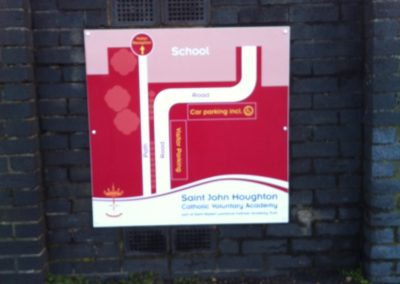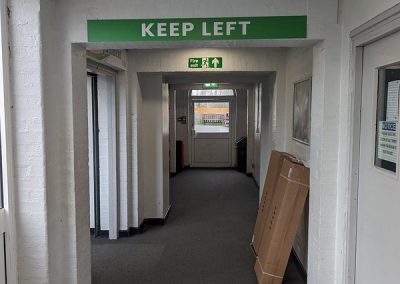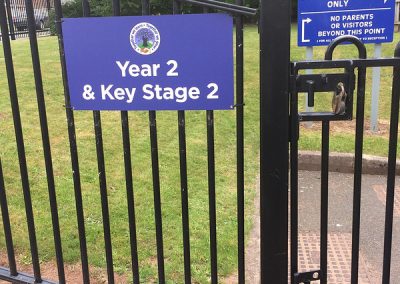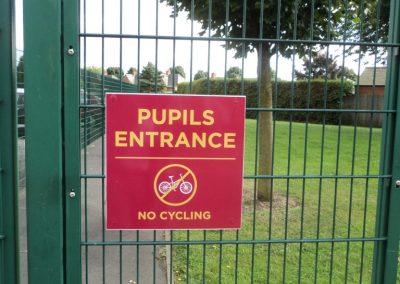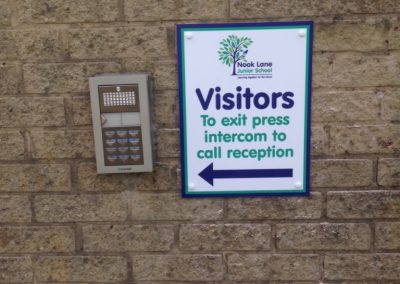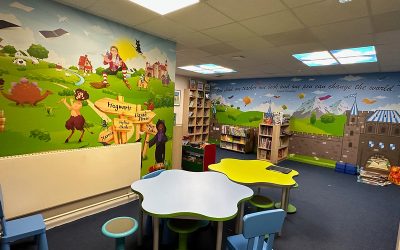Delivering Safe, Inclusive, and Connected School Communities with Smart Signage Design
Imagine a parent visiting your school for the first time, unable to locate the front office because of unclear or missing school signage. Or think of a student in a new building feeling lost and overwhelmed by the maze of corridors. These scenarios are all too common in educational settings where school signage has been overlooked.
In this article, we delve into why school signage matters, key elements to consider, and how to implement a signage strategy that enhances your school’s identity.
Why Is School Signage Essential?
One of the primary functions of school signage is to ensure that students, staff, and visitors can easily find their way around. Navigational signs, such as classroom labels, arrows pointing to dining rooms, and maps of the school layout, are particularly useful in large or multi-level buildings. A lack of clear directions leads to confusion and wasted time, especially for new students and visitors to the school.
Effective navigation also helps reduce congestion during peak times like morning arrivals and afternoon departures. This means fewer instances of students arriving late to class because they’ve taken a wrong turn or visitors wandering aimlessly looking for the main reception.
Why Is Safety a Top Priority for School Signage Design?
Safety is another crucial aspect of school signage. Directional signs for emergency exits, fire assembly points, and hazardous areas are not just recommended; they’re essential. In an emergency, the ability to quickly find the nearest exit can save lives. Similarly, well-placed signs in busy corridors or stairwells help reduce the risk of accidents by indicating where extra caution is needed.
Additionally, clear safety signage – such as ‘No Entry’ or ‘Restricted Area’ – helps staff maintain security and keep students out of potentially dangerous areas, such as maintenance rooms or chemical storage facilities.
How Can School Signage Create a Welcoming Environment?
First impressions matter, and the right school signage contributes significantly to creating a welcoming environment.
Imagine walking into a school where signs are consistent, branded with the school colours, and carrying positive messages like ‘Welcome’, or ‘Our School Values’. Such signage reinforces the school’s ethos and make students, staff, and visitors feel more connected to the community.
Signage can also reflect the school’s character, whether it’s showcasing achievements, displaying motivational quotes, or integrating creative, student-led designs. This approach transforms signage from merely functional to a key part of building a school’s identity.
What Are the Key Elements of Effective School Signage?
The most effective school signage is clear, concise, and easy to read. Use simple language and universally recognised symbols to minimise confusion. For example, large, contrasting fonts and high-visibility colours can be used to aid readability for students with visual impairments. Schools that cater to diverse student needs often use symbols or multi-language signs to ensure everyone can easily understand the instructions.
In addition to clarity of signage, consistency is a key principle in good school signage design. By maintaining a uniform style, colour scheme, and font throughout the campus, you create a cohesive visual language. This not only enhances the look and feel of your school, but also improves wayfinding as users become familiar with the sign patterns.
Additionally, consistency with school branding reinforces the institution’s identity. Think of signage as part of your school’s communication strategy; it should send the same messages as your school website, brochures, and uniforms.
We shouldn’t forget, either, that accessibility is a critical consideration for inclusive education. Signage should cater to diverse needs, including tactile elements for visually impaired students, height-appropriate signs for younger children, and audio indicators where necessary. Following legal requirements, such as the Equality Act in the UK, ensures that your signage is compliant and accessible to all members of your school community.
Finally, remember that school signage design doesn’t have to be boring. Integrating school colours, mascots, and inspiring quotes can transform simple signs into displays that foster pride and motivation. Balancing aesthetics with functionality helps to create a vibrant, engaging learning environment.
How to Implement Effective School Signage: A Step-by-Step Guide
Step 1: Where Should You Start?
Start by assessing your current signage situation. Walk through the school, identifying missing or outdated signs, and take note of areas where people commonly get lost. Engage with students, staff, and visitors to get their feedback on navigation issues.
Step 2: How Do You Plan and Design School Signage?
Develop a comprehensive signage plan that covers high-traffic areas, safety points, and locations requiring special instructions. Involve diverse stakeholders – such as parents, teachers, and students – to ensure your signage meets the needs of everyone. Consider different sign types, such as directional signs, safety notices, and inspirational displays for schools.
Step 3: What Materials Are Best for School Signage?
Choose materials that are durable, easy to maintain, and suitable for their environment. For exterior signs, opt for weather-resistant materials that can withstand sun, rain, and snow. For indoor signs, consider easy-to-clean surfaces, particularly in areas like cafeterias or science labs. Wherever possible, explore eco-friendly options that complement the school’s sustainability goals.
Step 4: How Should School Signage Be Placed and Installed?
Placement is crucial. Position signs at eye level, use arrows to indicate directions, and make sure they are visible from multiple angles. Avoid cluttering walls with too many signs, which can overwhelm and confuse. Instead, create clear paths that lead to important locations, using strategically placed markers to guide the way.
Step 5: Regularly Review and Maintain Your Signage
Implement a maintenance schedule to inspect and replace damaged, faded, or outdated signs. Regular updates are essential, especially if there have been changes to the school layout or safety procedures. Maintaining your school signage keeps it effective and ensures that it continues to meet legal and safety standards.
Quick Tips for Keeping School Signage in Good Condition
· Regular Cleaning and Maintenance
Assign a team to handle routine cleaning and ensure signs remain legible and vibrant.
· Create a Signage Inventory
Track each sign’s location, installation date, and material type to streamline repairs and replacements.
· Weatherproofing and Vandalism Prevention
Use anti-graffiti coatings, install protective screens, and opt for fade-resistant materials for outdoor signs.
Final Thoughts: School Signage Is More Than Simple Aesthetics
Getting your school signage right isn’t just about aesthetics; it’s about safety, inclusivity, and providing a clear sense of direction for everyone who steps into your educational establishment.
By investing in well-designed, consistent, and accessible displays for your school, you can improve navigation, enhance safety, and communicate the school’s values to everyone who enters the premises.
Take the time to evaluate your current school signage strategy and implement changes that reflect your commitment to building a better educational environment. After all, good signage is more than just direction – it shapes the entire experience of your school community.
To discuss how Design for Education can help you implement school signage that make a real difference – incorporating crucial design elements, using the highest-quality specialist materials with coatings that can be cleaned easily, and including UV protection that is guaranteed for five years – contact us today.
More like this…
School Wall Displays: Engaging Students Beyond the Classroom
Unlock the Hidden Power of Your Educational Environment School wall displays are a powerful yet often underutilised tool in education. The power of well-designed, vibrant school wall murals goes far beyond improving the aesthetics of a school. They become an extension...
School Walls as Learning Tools: Engaging Displays for Every Subject
Reimagining School Walls for Dynamic Education In the modern education environment, using school walls as learning tools helps teaching staff to go beyond textbooks and digital screens. Indeed, they are proving to be an integral visual learning tool, with research...
How School Wall Displays Inspire Your Students
The walls of a classroom do more than just enclose a space, they also shape your students learning environment. Thoughtfully designed school wall displays can ignite curiosity, celebrate achievements, and reinforce key concepts, making learning more engaging. Whether showcasing student work, visualising complex ideas, or creating an inspiring atmosphere, well-crafted displays encourage participation as well as motivation. The right visuals can transform your classroom into a dynamic, stimulating space that supports both academic success and personal growth.
Transforming School Walls: Inspiring Educational Spaces with Custom Wall Art
Transforming school walls with custom wall art can create inspiring educational spaces that foster creativity, motivation, and engagement among students. By incorporating vibrant designs that reflect a school’s values and curriculum, such as historical timelines or scientific concepts, educators can enhance learning environments and reinforce school identity. Thoughtfully designed wall art not only creates engaging spaces but also serves as an educational tool, turning blank walls into sources of inspiration.
Using Wall Art in School Libraries to Foster a Love for Reading
Creating Dynamic Reading Spaces with Murals and Interactive Displays Employing wall art in your school library is a wonderful way to create a vibrant, inviting atmosphere that encourages students to read more. From literary-themed murals to interactive graphics,...
10 Creative Wall Art Ideas for Primary Schools
Looking to brighten up your primary school’s walls? Our team have assembled 10 creative wall art ideas for primary schools which can transform dull spaces into vibrant, educational canvases. From murals that promote core values and inspire growth mindsets to interactive literacy and numeracy walls, these designs bring learning to life. Celebrate diversity, showcase history, or create themed learning corners – each idea fosters a welcoming environment and supports students’ development. Whether indoors or outdoors, school wall art is a powerful tool to reflect your school’s ethos, enhance engagement, and inspire creativity.







